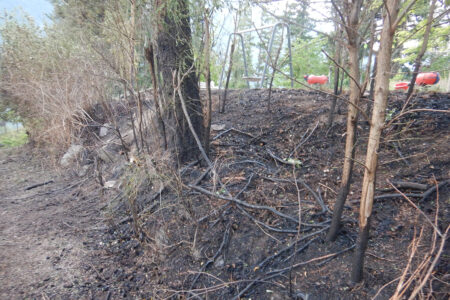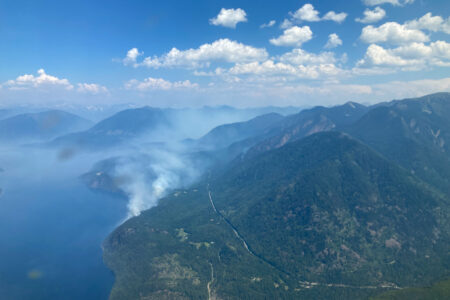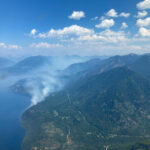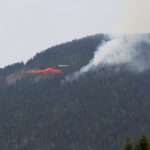Lake management plan reviewed
The annual review of the Christina Lake Management Plan (CLMP) hosted by the Christina Lake Stewardship Society (CLSS) included an interesting mix of topics that most would not immediately recognize as significant to watershed planning. Known across the province as a leader in watershed stewardship, the CLSS supports the implementation of the annual plan in partnership with different federal and provincial ministries, regional district, and local residents.
Throughout the day long session, held at the Christina Lake Community Hall on Thursday, Dec. 3, presentations were made by the different agencies involved in the watershed management. Ranging from reports on water quality, the Eurasian milfoil program, fish and fish habitat on the Kettle River, weed control programs, timber harvesting, to the foreshore inventory and mapping project and a preview of the proposed riparian area protection guidelines the day covered a lot of ground.
Nearly 40 people attended the meeting including Regional District of Kootenay Boundary (RDKB) chair Marguerite Rotvold, area D representative Irene Perepolkin, and the event was chaired by area C representative Grace McGregor. McGregor, who is the area representative for Christina Lake, is proud of the accomplishments of the society and the community’s management plan.
“We’ve worked really hard at the stewardship level and we’re actually quite well-known throughout the province. I’d like to see the stewardship society mentor others through their process. They are partners in the artisans project (Living Arts Centre.) Once that comes together I think that’s another way to bring people out and show them what we do from the stewardship level and how we do it,” said McGregor. The CLSS will be represented at the new Boundary regional water committee starting in the new year by local residents who are also members of CLSS.
The update of the remaining implementation strategy for the management plan and the development of action items for 2010 and beyond was left for individuals to send feedback to Brenda LaCroix, the co-ordinator of CLSS, through their email or by phone.
For more information on CLSS see their website: www.lakesteward.ca/index.html where their plan is posted along with reports, and other information. The report on this meeting will be posted to the site in the near future.
Water Quality
Presented by Danny St. Hilaire, water technician with the Environmental Protection Division of the Ministry of Environment, reviewed this year’s sampling results and the future steps for the program. St. Hilaire said that the samples show the lake met or was close to all objectives set for the year. Goals for the coming year include: updates on results to be posted to the ministry’s website, sampling to continue on the lake, and to continue to work with CLSS in future monitoring.
Eurasian Milfoil
Dave Caswell, the program supervisor under the RDKB of the milfoil control program provided a summary of the program and the changes they made in the methods used for collection. Milfoil is very invasive and must be treated by hand-pulling by divers. Other methods used in the past, such as lake bottom barriers, have proved ineffective in controlling the plants. The program at Christina Lake is the only one in B.C. doing diver removal only. Caswell said that they have better control of the fragments with their method and can prevent re-growth from fragments as a result. This year they had a working partnership with the University of B.C. (UBC) and were able to include more divers through the UBC program. In addition they did large scale sampling of the milfoil to check for weevils – a known natural predator for the plant. Future plans include continuing to work with UBC, augmenting the weevils by assisting in increasing natural populations, and developing a research and diver training program.
Kettle River Watershed
Tara White, senior fisheries biologist with the Ministry of Environment, reported on a three-year project to improve habitat along the Kettle River across the Boundary region. The project has seen efforts to improve habitat by building 29 structures from Midway to Rock Creek to allow for fish to survive in low water conditions by creating deep pools. White confirmed fears that record low water levels have been seen along the river in the last couple of years. With the low levels and high water temperatures, the ministry is working to develop a fish protection plan without compromising water use. Currently there are 225 licences along the river and no storage to supplement the river at low times. In the hot summers, White said the use outweighs the availability of water. Future goals are to conserve and restore native habitat with proactive water planning. The ministry is looking at developing a system for stream flow advisories to forecast and advise locals and users about water needs. White said that the Kettle Basin is the next basin to be developing a cross-ministry management plan working with a water committee being developed by the RDKB.
Riparian Protection Guidelines
Mark Andison, director of planning at the RDKB, presented the activities of the area planning committee regarding riparian areas. The draft guidelines will complement existing guidelines for developments affecting waterfront areas. The guidelines designate setbacks on riparian areas at 15 meters from water edges, but, according to the size of the lots involved, may vary. Andison noted that these guidelines conflict somewhat with the wildfire protection plans that have been recently released by the province. The next step for the guidelines is to allow for public input, probably next summer when the most residents are present, and then for the input to be considered by the planning committee.
Weed Management Program
Barb Stewart, co-ordinator of the Boundary weed management committee, gave a presentation on noxious and invasive plants in the area. In the past year, and for the next year as well, a team of workers, funded through the Job Opportunities Program of the federal and provincial government, did a number of weed management activities around the region. Stewart identified some of the more common problem plants in the Christina Lake watershed and outlined some of their efforts to reduce the weeds. Many of the participants were surprised that some of the invasive plants are ornamentals introduced by locals in their gardens. Often the seeds come with mixed wildflower seed packages. The committee’s plan for the coming year is posted on: www.rdkb.com.























